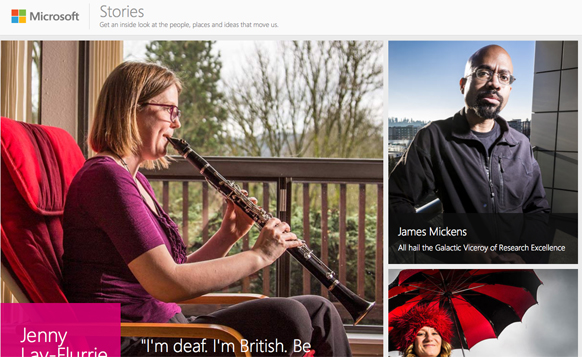Tech brand publishing: Microsoft Stories tells the right tales

Imagine running a business where behind the scenes there wasn’t just lots of dull clerical work, but a ton of switched-on, enthusiastic people experimenting at the cutting edge of technology to push your organisation forward.
Wouldn’t that be great? Isn’t that probably something you’d like to tell your customers about?
Previously, we have asked what makes good brand publishing and looked at best practice in financial services – a sector notorious for its heavy regulation and conservative approach to storytelling – but when looking for brands that are really good at developing innovative ways to talk about what they do well, technology companies are a great place to start.
Generally, they’re more forward-looking and responsive to the way the audience wants to consume its information. They’re also usually pretty good and connecting people to relevant content.
Microsoft employs a small team of writers and editors – mainly former journalists – whose job is to find the compelling people, stories, and projects taking place at the company and to bring them to wider attention.
They don’t do anything radical, they do exactly what journalists have been doing for centuries: they find human stories, and interesting people, and write about them.
Think of Microsoft as a small town and its writers the staff of the local newspaper. Basically, that’s how it works. They have an editorial meeting, discuss sources for compelling project, and talk about the great people they should profile – and why they should be profiled.
They ask critical questions of proposed projects, put stories together with editorial rigour, then use them cheerlead for Microsoft. This team tells the wider world about what’s going on inside the company.
And what stories they have to tell…
In 88 Acres, the team revealed how engineers at Microsoft invented a piece of building management software for its 125-building campus in Washington State. Not only did the software conserve energy, it saved Microsoft millions of dollars in the process.
The team has also written about The Garage, a place on the Microsoft campus where staff can try to make something out of their wildest ideas. It’s Geek Central. A place where people can indulge flights of fancy (volcanoes that fire smoke and pyrotechnics, anyone?) or try out practical ideas, such as the ‘Forgotten Attachment Detector’, that might later be incorporated into products used across the world.
The response to these tales has proved so positive, Mircrosoft’s team of writers decided to launch ‘Stories’ late last year, as an online destination where all these amazing narratives could find a home.
Microsoft also expanded its Stories team to include designers, photographers, and illustrators so that each tale wasn’t limited to just text and pictures. The additional skills they brought allowed the Stories team to tell their tales in the most suitable way possible.
Lead writer Jennifer Warnick explained to Contently:
“In developing a story about The Garage, our team would inadvertently build a sort of garage of our own – a metaphorical storytelling shed for thinking and tinkering. For us, these were the noodles – the lessons – that stuck.”
This meant creating a Field Guide to bring to life the characters found at The Garage, adding interactive and embeddable page elements, illustrations, and a sideshow with video that plays on the page. The team even created a Pintrest page to show where they found inspiration for parts of The Garage piece.
But what does all this creative endeavour deliver? How, from a branding and marketing point of view, does Microsoft make this pay?
Just weeks after publication of 88 Acres, retailers, educational institutions and government departments across the world contacted Microsoft to find out more about the building software detailed in the story. So, something that was built for internal use is now a product.
And as for branding?
Well, if you want customers to readily associate your brand with innovation, what better than The Garage story?Or how about stories highlighting the most devoted, restless, and enthusiastic people at your company? Why not show how they are brimming with ideas and inquisitiveness?
Those are the kind of brand ethics every forward-looking company should be keen to promote.
But the important thing to remember, as Warnick is at pains to make clear, is that none of this storytelling would work if there wasn’t a story to tell.
The critical thing for the success of these content projects is that they are engaging for the audience. They have to be informative, but most of all they have to be fun.